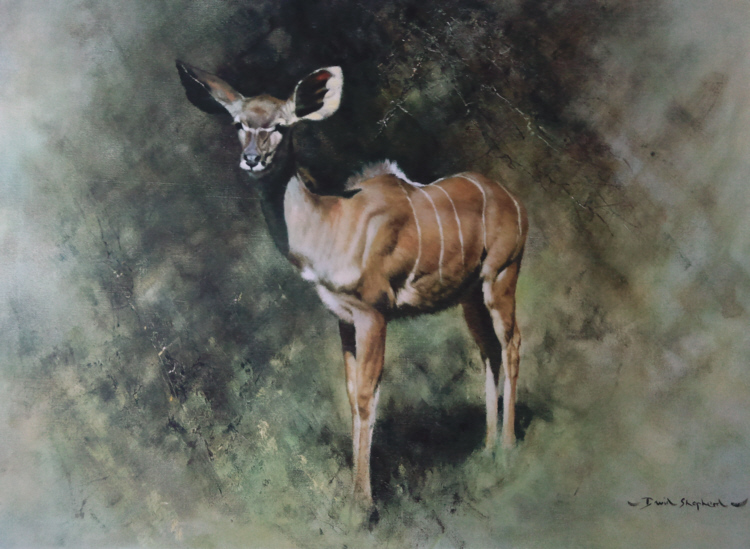Kudu
David Shepherd

'Kudu'
Limited Edition of 1,800
Date of publication 1969
Image Size 29" x 21"
Single female Kudu
In stock_; price please call 01623 799 309
Is a kudu a deer?
Kudu, or koodoo, is the Khoikhoi and seTswana name for this antelope.
Tragos (Greek) denotes a he-goat and elaphos (Greek) a deer. Strepho (Greek) means 'I twist', and strephis is 'twisting'.
Keras (Greek) refers to the horn of the animal.
Like many other antelopes, male kudus can be found in bachelor groups, but they are more likely to be solitary.
Their dominance displays tend not to last long and are generally fairly peaceful, consisting of one male making himself look big by making his hair stand on end.
When males do have a face-off, they will lock their horns in a competition to determine the stronger puller; kudus' necks enlarge during the mating season for this reason.
Sometimes two competing males are unable to unlock their horns and, if unable to disengage, will die of starvation or dehydration.
Males are seen with females only in the mating season, when they join in groups of 5–15 kudus, including offspring. Calves grow very quickly and at six months are fairly independent of their mothers.
A pregnant female will leave the herd to give birth to a single offspring. She will leave the newborn lying hidden for 4–5 weeks while coming back only to nurse it, which is the longest nursing period of any antelope species.
Then the calf will start accompanying its mother for short periods. At 3 or 4 months, the calf will be with its mother constantly, and at about six months they will rejoin the group.
When threatened, kudu will often run away rather than fight.
Wounded bulls have been known to charge an attacker, hitting the attacker with their sturdy horn base rather than stabbing it.
They are great kickers and are capable of breaking a wild dog's or jackal's neck or back.
They are good jumpers and can clear a 5 foot fence from a standing start.